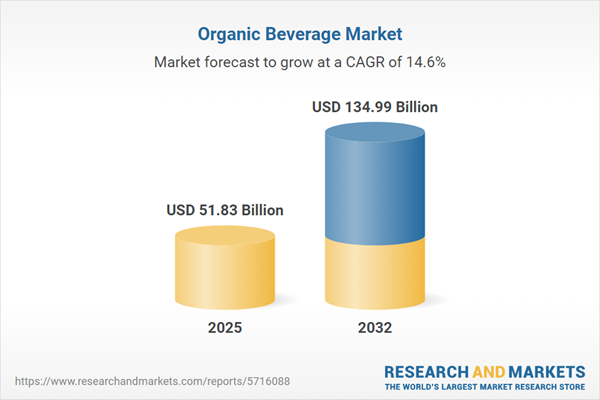Speak directly to the analyst to clarify any post sales queries you may have.
The organic beverage market is undergoing rapid evolution, guided by senior executives prioritizing wellness, sustainability, and ethical operations. This sector’s persistent transformation is demanding continual innovation, strategic focus, and resilient practices to maintain global competitiveness.
Market Snapshot: Organic Beverage Market Forecast and Growth Drivers
The organic beverage market is currently demonstrating robust expansion, with measurable compound annual growth and increased reach across mature and emerging economies. Key drivers include heightened consumer attention to health and ethical considerations, as well as a significant shift toward transparency throughout the value chain. Executive leadership teams are championing sustainability initiatives and harnessing data-driven decision-making, deploying advanced analytics to refine market relevance and ensure compliance. These strategies provide agility, enabling organizations to meet the needs of diverse consumer groups while reinforcing their position in an evolving regulatory environment.
Scope & Segmentation: Strategic Overview of the Organic Beverage Market
This executive-focused report delivers actionable insights and strategic direction for senior decision-makers mapping key opportunities in the organic beverage sector. Segmentation is organized to address areas offering the highest potential for differentiation and competitiveness:
- Product Types: Coffee-based drinks address daily energy, while flavored waters and juices meet hydration needs. Sports drinks target performance-oriented consumers. Teas are positioned for relaxation and wellness-focused segments across various demographics.
- Distribution Channels: Supermarkets and specialty retail outlets offer traditional buying experiences. E-commerce platforms extend reach, with omnichannel integration boosting convenience and market penetration through seamless digital and physical presence.
- Packaging Types: Glass and plastic bottles, aluminum cans, paper cartons, and flexible pouches each balance concerns of shelf appeal and sustainability, aligning with environmentally minded consumers and authentic brand positioning.
- Flavor Segments: Offerings span fruit-based, vegetable, and mixed flavors. Producers are also tapping into trends with functional botanicals and novel infusions, keeping pace with shifting wellness preferences.
- Geographic Regions: Distinct market dynamics emerge in the Americas, Europe, Middle East, Africa, and Asia-Pacific. Each region influences entry strategy, regulatory compliance requirements, and local partnership development.
- Featured Companies: Danone S.A., The Coca-Cola Company, PepsiCo, Inc., and Keurig Dr Pepper Inc. are recognized as industry leaders. Their advanced innovation practices and strategic initiatives provide valuable benchmarks for operators within the organic beverage landscape.
Key Takeaways for Executive Leadership
- Building trust through clear communication of ingredient origins and comprehensive process transparency strengthens relationships across the value chain.
- Implementing smart packaging and enhanced labeling supports regulatory compliance, meets rising demands for traceability, and elevates perceived product value.
- Expanding functional beverage offerings to include options such as plant-based proteins, probiotic cultures, or botanicals addresses health trends and targets new consumer segments.
- Connecting retail, digital commerce, and direct-to-consumer channels boosts agility, ensuring swift adaptation to changing market forces and consumer behaviors.
- Fostering visibility across the supply chain nurtures sustainable sourcing and business continuity, reinforcing supplier reliability and minimizing disruptions.
- Aligning operational strategies with regional market specifics and cultivating local partnerships helps organizations maintain compliance and achieve sustained brand loyalty.
Tariff Impact: Navigating Shifts in U.S. Trade Policies
Recent changes in U.S. tariffs are prompting organic beverage producers to adjust operational tactics. Strategies include broadening the supplier base, prioritizing domestic sourcing, and favoring recyclable or locally available packaging. Flexible supplier contracts and adaptive logistics play essential roles, maintaining reliable supply chains and supporting sustainability commitments throughout regulatory transitions.
Methodology & Data Sources
This report is informed by interviews with senior executives, comprehensive consumer research, and a systematic review of regulatory and sustainability initiatives. Inputs from stakeholders across the value chain ensure recommendations are actionable and pertinent to real-world market developments.
Why This Organic Beverage Market Report Matters
- Empowers leadership to tailor adaptive strategies that address ongoing shifts in the organic beverage market landscape.
- Positions organizations to efficiently navigate regulatory changes and respond to operational challenges, enhancing resilience and decision-making speed.
- Highlights high-potential opportunities for investment, operational alignment, and sustainable competitive advantage.
Conclusion
Organizational success in the organic beverage market centers on continuous improvement, strategic adaptability, and collaborative innovation, ensuring enduring value against shifting operational and regulatory demands.
Additional Product Information:
- Purchase of this report includes 1 year online access with quarterly updates.
- This report can be updated on request. Please contact our Customer Experience team using the Ask a Question widget on our website.
Table of Contents
3. Executive Summary
4. Market Overview
7. Cumulative Impact of Artificial Intelligence 2025
Companies Mentioned
The companies profiled in this Organic Beverage market report include:- Danone S.A.
- The Coca-Cola Company
- PepsiCo, Inc.
- Keurig Dr Pepper Inc.
- The Hain Celestial Group, Inc.
- Ocean Spray Cranberries, Inc.
- CROPP Cooperative
- The J. M. Smucker Company
- The Vita Coco Company
- GT's Living Foods, LLC
Table Information
| Report Attribute | Details |
|---|---|
| No. of Pages | 190 |
| Published | November 2025 |
| Forecast Period | 2025 - 2032 |
| Estimated Market Value ( USD | $ 51.83 Billion |
| Forecasted Market Value ( USD | $ 134.99 Billion |
| Compound Annual Growth Rate | 14.6% |
| Regions Covered | Global |
| No. of Companies Mentioned | 11 |









